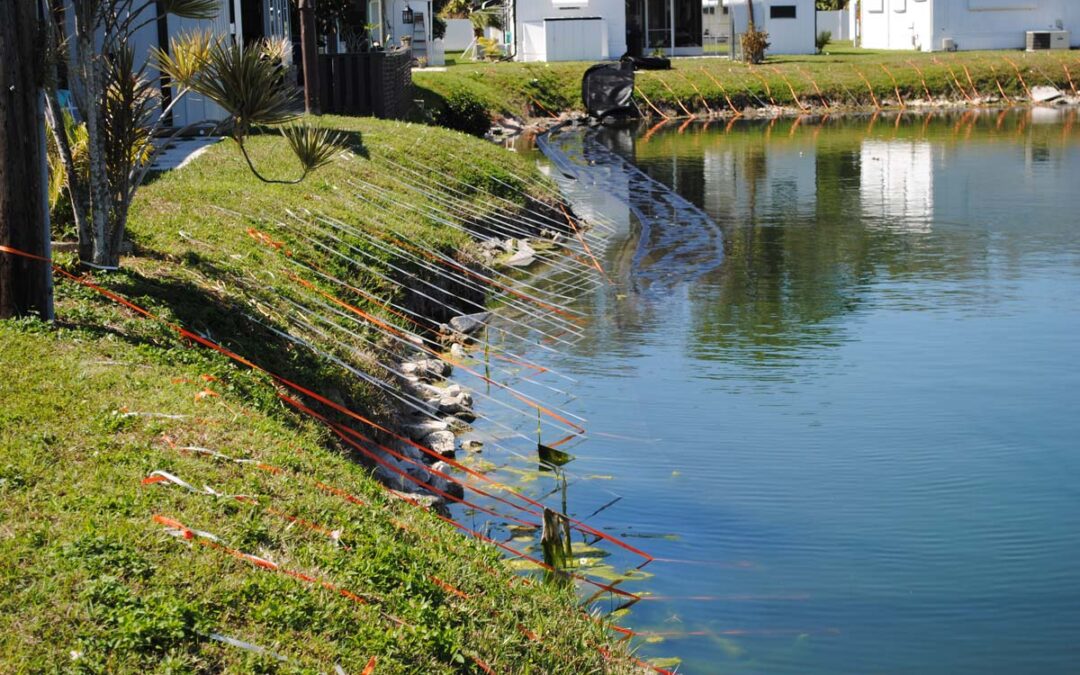When heavy rains arrive, drainage issues often become evident, transforming streets into canals and causing backyard swales to resemble river rapids. It is crucial for homeowners to understand the drainage features of their property and take proactive measures to maintain them. In this article, we will explore the connection between poor drainage and erosion along lake and pond shorelines. We will discuss the various erosion-related issues that can arise from inadequate drainage and provide effective measures to mitigate erosion risks.
The Impact of Poor Drainage on Shoreline Erosion:
Poor drainage significantly contributes to erosion along lake and pond shorelines. Here are the key erosion-related issues that can result from inadequate drainage:
1. Saturation of Soils:
Insufficient drainage leads to saturated soils along the shoreline. When soil becomes saturated, its strength and stability are compromised, making it more susceptible to erosion. Flowing water, wave action, and wind can easily erode saturated soils, causing shoreline erosion.
2. Increased Hydrostatic Pressure:
Lack of proper drainage can cause water to accumulate behind the shoreline, resulting in increased hydrostatic pressure. This pressure exerts force on the soil, leading to soil movement, slumping, or collapse. As the soil is washed away or collapses into the water, the shoreline erodes.
3. Concentrated Runoff:
Inadequate drainage often leads to concentrated runoff, where water flows rapidly and forcefully in specific areas. Concentrated runoff carries more erosive power and can scour the shoreline, removing soil and sediment. This can create gullies or channels along the shoreline, exacerbating erosion.
4. Waterlogging and Reduced Vegetation Growth:
Poor drainage can cause waterlogging of the soil, creating unfavorable conditions for vegetation growth. Vegetation plays a critical role in stabilizing topsoil along shorelines by anchoring the soil with their roots. When waterlogged conditions inhibit vegetation growth, the shoreline becomes more vulnerable to erosion.
Mitigating Erosion through Proper Drainage:
To address erosion caused by poor drainage, it is essential to implement appropriate drainage measures. Consider the following strategies:
- Installing drainage systems such as perforated pipes or subsurface drains to remove excess water from the shoreline area.
- Implementing swales or ditches to collect and redirect surface runoff away from vulnerable areas.
- Constructing berms or embankments to divert water flow and prevent it from reaching critical erosion-prone areas.
- Improving the grading and contouring of the shoreline to promote efficient drainage patterns.
- Establishing vegetation, such as native grasses or plants with deep root systems, to stabilize the topsoil and absorb excess water.
Consulting Professionals for Effective Solutions:
Proper design and implementation of drainage systems are vital for maintaining the stability and integrity of lake and pond shorelines, reducing erosion risks, and preserving the surrounding ecosystem. To address poor drainage and erosion concerns specific to a lake or pond, it is advisable to consult professionals experienced in shoreline management and erosion control. They can provide valuable guidance and expertise tailored to your specific needs.
Conclusion:
Understanding the link between poor drainage and erosion along lake and pond shorelines empowers homeowners to take proactive measures in managing their properties. By implementing appropriate drainage strategies, homeowners can effectively mitigate erosion risks, preserve their shorelines, and contribute to the overall health of the surrounding ecosystem. Seeking professional advice and assistance will further enhance the success of erosion control efforts. Let’s work together to protect our valuable water resources and ensure the long-term sustainability of our lake and pond environments.
If you have any questions or concerns about your drainage infrastructure, we encourage you to reach out to Landshore. Our team of experts is ready to review your specific challenges and assist you in finding the best possible solutions. For more valuable insights and updates from our engineering team, be sure to follow us on our social media channels listed below. We look forward to connecting with you and helping you achieve optimal drainage for your property.

